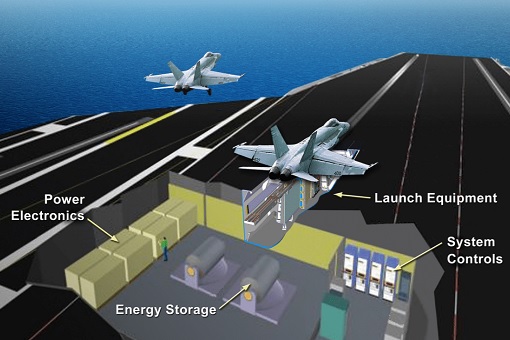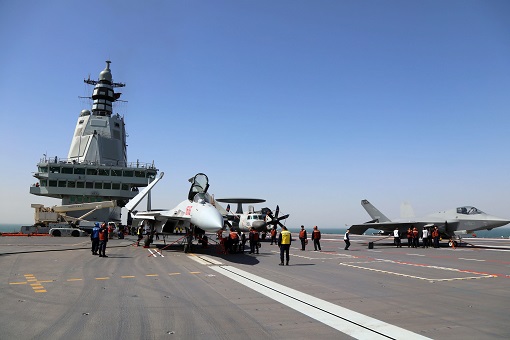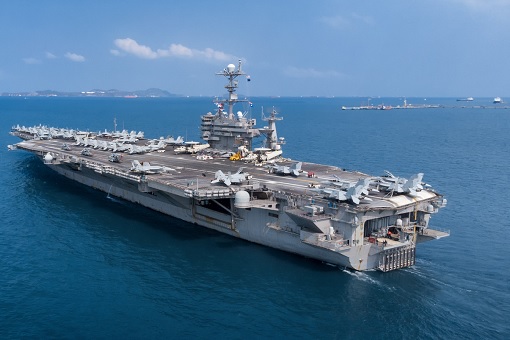
China’s New War Machine – Fujian Aircraft Carrier Enters Service
November 10th, 2025 by financetwitter
Launched in 2022 and began sea trials in 2024, China’s latest war machine – the Fujian aircraft carrier – has effectively entered service. Even though the carrier is powered by conventional fuel, meaning it must either make a port call or be met by a tanker at sea to refuel, the U.S. isn’t laughing. The Fujian is a game-changer, which has raised eyebrows in the West.
A fourth carrier, designated Type 004, believed to be nuclear-powered, is currently being built at the Dalian shipyard. While the Chinese government has not officially confirmed the Type 004, satellite imagery provides evidence of its construction. From thereafter, it would be a matter of replicating Type 004. China plans to have a fleet of at least six aircraft carriers by 2035.
As a start, the Fujian, which received the hull number 18 – China’s third and most advanced aircraft carrier – features electromagnetic catapults. The new tech, known as EMALS, allows planes to take off with heavier weapon and fuel loads, so they can strike enemy targets at greater distances. The only other aircraft carrier in the world that has the EMALS system is the U.S. Navy’s newest carrier, the USS Gerald R Ford.

On Chinese social media Friday, news of the commissioning was a top trending subject, with a hashtag “My country’s first electromagnetic catapult-equipped aircraft carrier enters service” racking up more than 10 million views in the space of an hour. It was such a big deal that Chinese President Xi Jinping attended the ship’s commissioning ceremony on Wednesday (Nov 5), pressing the launch button inside the control “bubble”.
Electromagnetic Aircraft Launch System (EMALS) is a new and complex technology, so much so that even the U.S. has not mastered it. In fact, U.S. President Donald Trump says he plans to sign an executive order that would compel the U.S. Navy to revert to using steam-powered catapults and hydraulic elevators on new aircraft carriers. Apparently, there were problems with Ford’s EMALS system.
Trump is against the EMALS catapults and Advanced Weapons Elevators (AWE) on the USS Gerald R. Ford, the Navy’s most powerful supercarrier, for years because Ford‘s catapults and elevators have been plagued with reliability and maintenance issues. The U.S. Navy currently has 10 Nimitz class carriers, which have steam-powered catapults and hydraulic weapons elevators.

“They’re spending billions of dollars to build stupid electric. And the problem, when it breaks, you have to send up to MIT, get the most brilliant people in the world, fly them out. The steam, they said they can fix it with a hammer and blowtorch. And it works just as well, if not better,” – complained Trump. However, replacing EMALS on the Ford would be a design nightmare and disaster.
Even though Ford and Fujian are using the same EMALS system, the Fujian’s electromagnetic catapult system uses medium-voltage direct current (compared to Ford’s alternating current) and has a failure rate below 0.2%, making it 80 times more reliable, according to technical analyses and Pentagon reports. You don’t think China would blindly copy the U.S.’s problematic system, do you?
The Ford’s EMALS recorded roughly 600 cycles between failures during 2022 testing, far below the target of 4,166 cycles, according to a Pentagon report (February 2023). The key difference lies in system architecture – the U.S. design shares power among its four catapults, while the Chinese version uses independent power modules for each one. In case of malfunction, a catapult can be isolated within 0.8 seconds without affecting the others.

As a result, even though the USS Gerald R. Ford is designed to operate the F-35C Lightning II, the fifth-generation stealth fighter cannot be fully integrated with the Ford’s EMALS, forcing the F-35 to operate only from steam catapults on Nimitz-class carriers. The Fujian, meanwhile, successfully conducted the world’s first operational electromagnetic catapult launch of a fifth-generation stealth aircraft – the Shenjang J-35 – on Sept 22, 2025.
During the ceremony of Fujian officially entering the service, the flight deck was showing China’s J-35, J-15T, KJ-600 airborne early warning aircraft and Z-20F helicopter to send a message to the U.S. – the Chinese is fast catching up, if not already ahead. With Fujian, China has skipped older steam catapult technology entirely and goes directly to using an advanced electromagnetic launch system (EMALS), a decision made by President Xi himself.
Crucially, the Chinese Fujian demonstrated an average of 12.5 aircraft launches per hour, surpassing the U.S. Nimitz-class average of 10 launches per hour. Steam catapults require 30–60 minutes to build up pressure and 30–60 seconds to recharge between launches. The Chinese electromagnetic system maintains a consistent 45-second interval and can reach operational readiness within 15 minutes, reducing response time by up to 75%.

The ability of an EMALS to launch smaller and more fragile designs is seen as particularly critical to opening the door to future carrier-based drone operations, something the PLAN is very actively pursuing. Yes, the Fujian’s EMALS isn’t about how fast and how smooth the system can send conventional fighter jets to the sky, but more about a future war with the U.S. in launching drones.
It’s not a coincidence that the Chinese People’s Liberation Army Navy (PLAN) is also set to receive a number of very large big-deck amphibious assault ships, referred to now as the Type 076, with at least one electromagnetic catapult that is expected to be primarily used to launch drones. It is designed to take sea-to-land assaults to the next level – a vessel capable of launching fighters and fixed-wing drones.
Ford isn’t facing problems with just its EMALS, electronically-controlled Advanced Arresting Gear (AAG), and Advanced Weapons Elevators (AWE). Other elements of the carrier’s design, especially its Dual Band Radar (DBR) system, have faced challenges as well after the immature technology was forcefully integrated into the ship. The carrier’s critical sensor system is not functioning correctly.

Unless Ford fixes all its problems, which has taken years now, the plan to replace all the existing 10 Nimitz-class carriers with Ford-class aircraft carriers as part of a long-term US Navy fleet modernization plan will be affected. Fujian’s commissioning, on the other hand, shows that China has made another important step forward for the Chinese carrier force and its larger naval modernization plans.
The fact that Fujian is also China’s first carrier that is not based on a Soviet design is a point of national pride. Liaoning was originally laid down in the Soviet Union as the planned sister ship to the long-troubled Admiral Kuznetsov. Work on the ship came to a halt with the fall of the Soviet Union. The government of the newly independent country of Ukraine then came into possession of the incomplete Kuznetsov class carrier and ultimately sold it to Chinese buyers.
China’s second aircraft carrier – the Shandong – which was entirely built in China and derived from Liaoning‘s design, was built to demonstrate China’s capability in producing domestic aircraft carrier. It serves as a stepping stone (or a learning curve and a training ground) for future, more advanced carriers (such as the Fujian), and its development is a significant milestone in China’s efforts to project power.

But the Chinese third aircraft carrier could be just the appetizer. Experts estimate that the nuclear-powered Type 004 could displace up to 110,000 tons, exceeding even the U.S. Navy’s Nimitz, and even the Ford-class supercarriers. The country already possesses the world’s largest navy by number of ships, surpassing the U.S., although its vessels remain smaller.
Recognized by even the Western power as the first non-U.S. supercarrier, the 80,000-tons Type-003 Fujian may comprise 24 Shenyang J-15 multirole fighters, 4 J-15D electronic warfare aircraft, 12 next-generation J-35 fighters, 8 Changhe Z-18 transport helicopters, 4 Harbin Z-9 multirole helicopters, and 4 Xi’an KJ-600 airborne early warning aircraft. It is the largest non-nuclear warship in the world.
Make no mistake – the Fujian isn’t just another massive floating ship with bells and whistles. China does not believe in wasting money building something to be boastful. In addition to project power regionally like the U.S., the Chinese newest aircraft carrier was hatched as part of any future intervention against Taiwan, as well as to enable longer-range blue water operations in the Pacific and beyond.

In a recent report to the US Congress, the Pentagon described China’s military as “the only competitor to the United States with the intent and, increasingly, the capacity to reshape the international order.” They are fielding and building more aircraft carriers, they’re fielding more nuclear-powered subs, they are fielding more, larger destroyers and other vessels that carry a larger number of missiles.
No matter how analysts downplay China’s three carriers compared to the US Navy’s 1, the fact remains that Chinese shipyards have the capabilities to build more than one at once and have also been churning out other new vessels at a pace the US can’t currently come close to matching. They are really catching up and closing the gap.
I recommend the 4th one be named Taiwan.
ReplyDeletewho the f*ck r u?
DeleteFujian is basically meant for Bullying South East Asian countries.
ReplyDeleteparading yr know-nothingness in military HW.
DeleteWakakakaka…